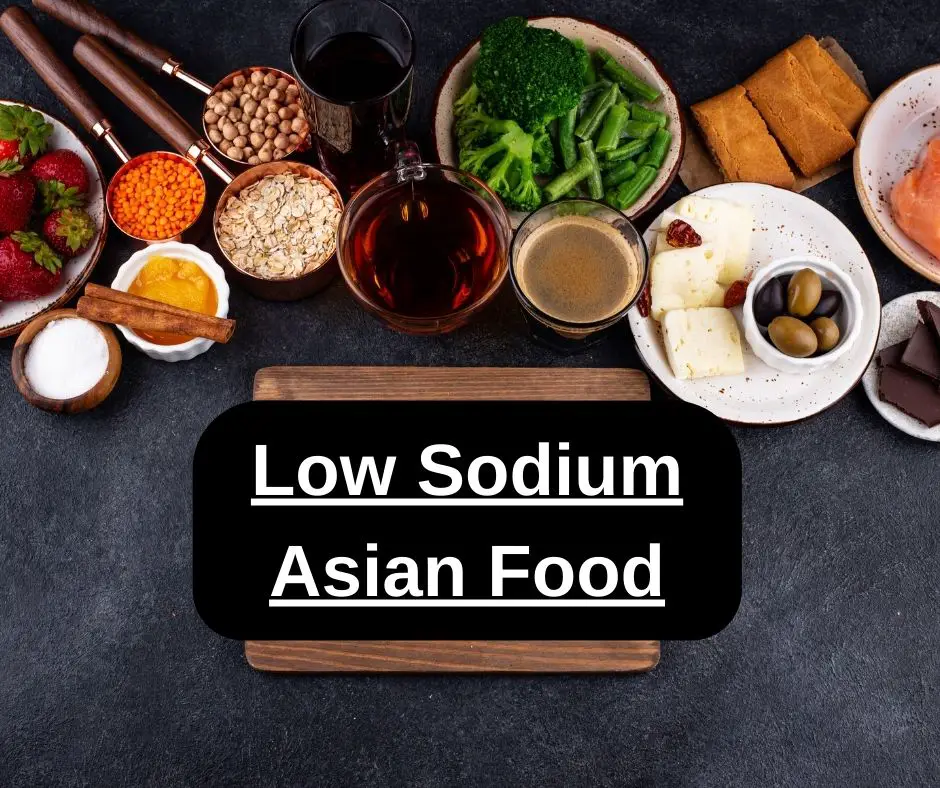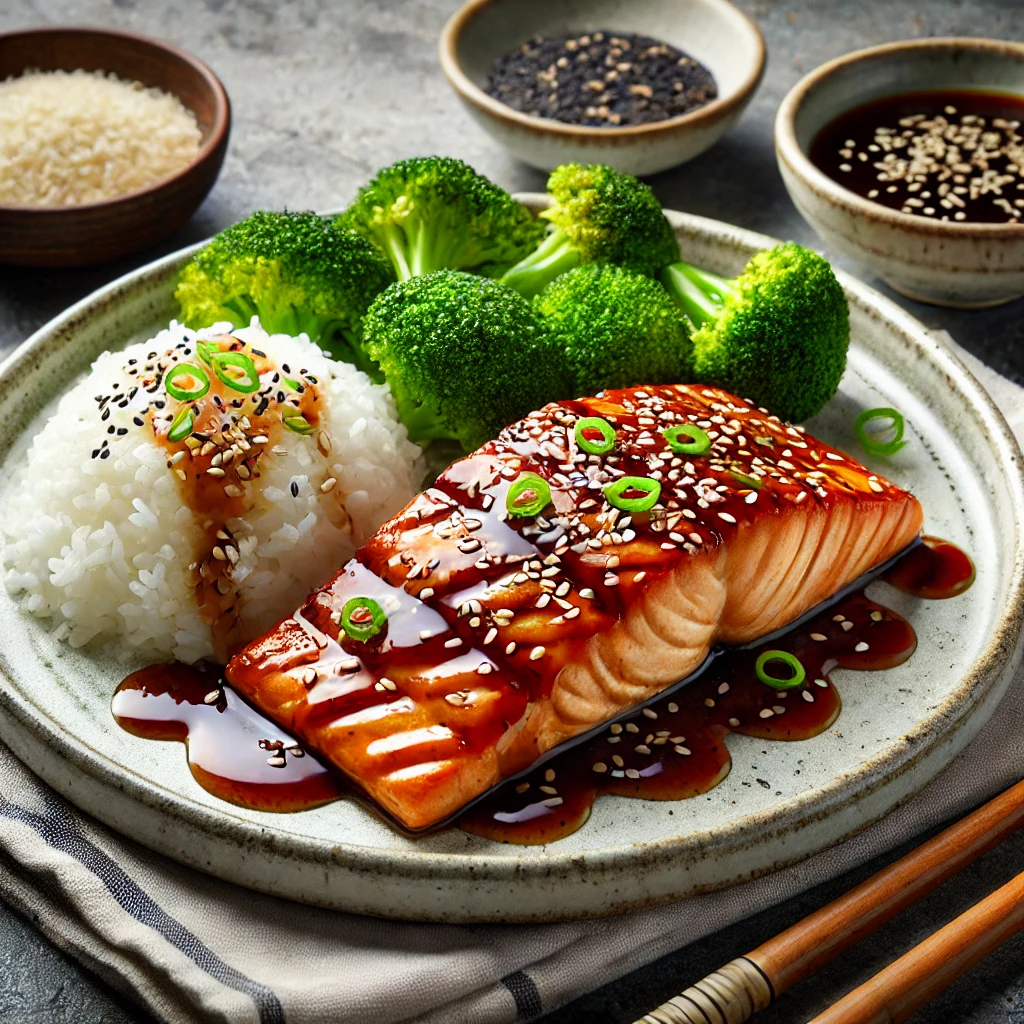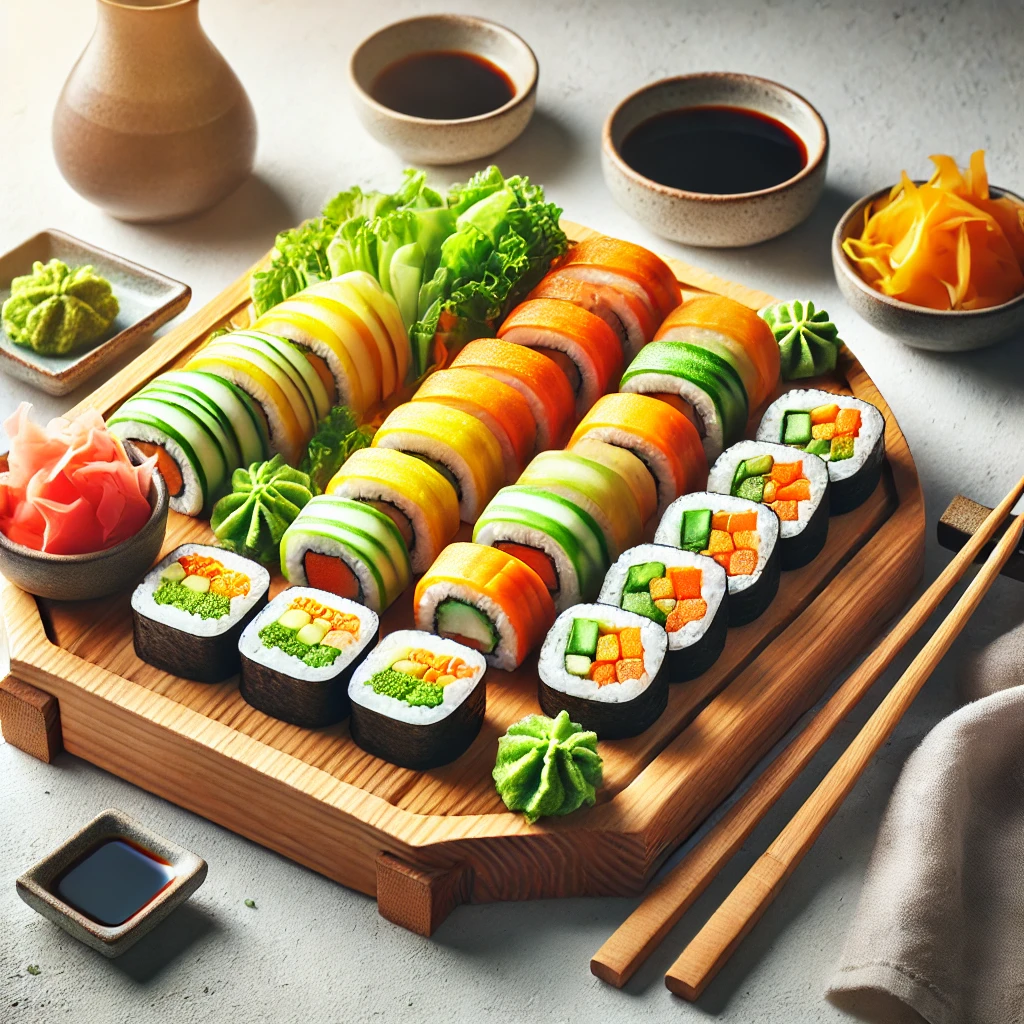Introduction: Low Sodium Asian Food. Asian food, such as cuisine, is known for its bold flavors, vibrant colors, and diverse culinary traditions. However, many Asian dishes tend to be high in sodium, which can be detrimental to our Health if consumed excessively.
In this article, we will explore the concept of low-sodium Asian food, understand the impact of sodium on our Health, discover the benefits of consuming low-sodium options, and provide tips and delicious recipes to help you enjoy Asian flavors without compromising your Health.
Asian food encompasses various flavors, including Chinese, Japanese, Thai, Korean, and Vietnamese cuisines. While these cuisines are incredibly diverse, they often share a common ingredient: sodium. Let’s read about Low Sodium Asian Food.

Table of Contents
Understanding Sodium and its Impact on Health
Sodium is a necessary electrolyte that helps regulate fluid balance, nerve function, and muscle contraction in our bodies. However, the average modern diet tends to be high in sodium, mainly due to processed foods and restaurant meals.
Excessive sodium intake can result in fluid retention, increased blood pressure, and tension in the heart and blood vessels. Reducing our sodium consumption can lower the chances of these health problems and improve our overall well-being.
Health Benefits of Reducing Sodium Intake
Reducing sodium intake offers numerous health benefits, particularly for the cardiovascular system. High sodium consumption is closely linked to hypertension, a leading risk factor for heart disease and stroke. By lowering sodium levels in your diet, you can help maintain healthy blood pressure, reducing the strain on your heart and blood vessels.
A low-sodium diet also supports kidney health. Excess sodium can overburden the kidneys, leading to fluid retention and increased risks of kidney stones or chronic kidney disease. By reducing sodium, you allow your kidneys to function more efficiently, promoting overall well-being.
Additionally, cutting back on sodium can reduce bloating and swelling caused by water retention, improving overall comfort and appearance. It also plays a role in bone health, as excessive sodium can lead to calcium loss, increasing the risk of osteoporosis.
Incorporating low-sodium options into your diet not only minimizes health risks but also enhances your overall quality of life by preventing long-term complications and promoting a balanced, heart-healthy lifestyle. Simple changes, such as choosing fresh ingredients and avoiding heavily processed foods, can make a significant impact on your health over time.
Benefits of consuming low-sodium Asian food
Opting for low-sodium Asian food can offer several benefits:
- It allows us to enjoy the rich flavors of Asian cuisine while minimizing the potential health risks associated with excessive sodium intake.
- Reducing sodium intake can lead to better blood pressure control and decreased risk of cardiovascular diseases.
- Consuming low-sodium Asian dishes can promote a healthier lifestyle and assist in weight management.
Common high-sodium ingredients in Asian cuisine
Asian cooking often involves certain ingredients naturally high in sodium or commonly used in salted forms. These ingredients include soy sauce, fish sauce, oyster sauce, shrimp paste, and various fermented products.
While these ingredients contribute to the characteristic umami flavor in Asian dishes, they can also significantly increase the sodium content. Therefore, it’s important to be mindful of these ingredients when preparing low-sodium Asian meals.
Asian cuisine is renowned for its bold flavors, often achieved using ingredients that are naturally high in sodium. Recognizing these ingredients and their alternatives can help you enjoy your favorite dishes while managing sodium intake.
- Soy Sauce: A staple in many Asian dishes, soy sauce is a primary source of sodium. Even small amounts can significantly increase sodium levels in a meal. Opt for low-sodium soy sauce or alternatives like coconut aminos to reduce salt content without compromising flavor.
- Fish Sauce: This fermented condiment is a key ingredient in Southeast Asian cuisine, providing umami depth. However, it is also very high in sodium. Using diluted fish sauce or a mix of lime juice and light soy sauce can offer a similar flavor profile with less sodium.
- Oyster Sauce: Often used in stir-fries and marinades, oyster sauce combines sweetness and saltiness but contains high sodium levels. Low-sodium versions or homemade substitutes using mushroom broth and a dash of molasses can be healthier options.
- Miso Paste: A common ingredient in Japanese soups and marinades, miso is high in sodium due to its fermentation process. Using lighter varieties of miso or reducing the amount in recipes can help lower sodium intake.
- Pickled Vegetables: Ingredients like kimchi, pickled radish, and preserved mustard greens are rich in flavor but also high in sodium due to the pickling process. Fresh vegetables or lightly salted versions can be better alternatives.
- Fermented Bean Pastes: Products like gochujang (Korean chili paste) and black bean paste are flavor-packed but sodium-heavy. Use them sparingly or look for reduced-sodium versions to manage salt content.
- Dried Seafood: Items like dried shrimp or anchovies are often used to enhance flavor in soups and stocks but are naturally high in sodium. Fresh seafood or unsalted versions can provide similar flavor without excess salt.
- Instant Noodles and Soup Bases: Pre-packaged noodles and soup bases are convenient but typically contain high amounts of sodium in their seasoning packets. Preparing homemade broths and noodles allows you to control sodium levels.
- Salted or Roasted Nuts: Often used as toppings in Asian dishes, these nuts can add unnecessary sodium. Opt for unsalted or raw versions to maintain flavor without the added salt.
- MSG (Monosodium Glutamate): Widely used to enhance umami flavor, MSG is a concentrated source of sodium. Choosing recipes that rely on natural flavor enhancers like mushrooms or seaweed can reduce sodium intake effectively.
By identifying and moderating the use of these high-sodium ingredients, you can enjoy the rich flavors of Asian cuisine while maintaining a healthier, low-sodium diet.
Tips for reducing sodium in Asian cooking
Creating low-sodium Asian dishes requires a few simple adjustments to traditional recipes.
Choose low-sodium alternatives: Look for low-sodium versions of soy sauce, fish sauce, and other condiments. These alternatives can significantly reduce the sodium content without compromising the taste.
Use fresh ingredients: Opt for fresh herbs, spices, and aromatics to enhance flavors instead of relying solely on sodium-laden sauces and seasonings.
Control portion sizes: Reducing the high-sodium ingredients used in your recipes allow you to enjoy the flavors while keeping the sodium content low.
Rinse and soak: If using preserved or fermented ingredients, rinse or soak them before cooking to reduce the sodium levels.
Experiment with herbs and spices: Explore the vast array of Asian herbs and spices, such as ginger, garlic, lemongrass, and chili peppers, to add depth and complexity to your dishes without relying on excessive sodium.
Delicious low-sodium Asian recipes
Below are some Delicious low-sodium Asian recipes
Grilled Teriyaki Salmon

Ingredients:
- Fresh salmon fillets
- Low-sodium teriyaki sauce
- Lemon juice
- Garlic powder
- Sesame seeds
- Green onions, chopped
Instructions
- Preheat the grill to medium-high heat.
- Mix low-sodium teriyaki sauce, lemon juice, and garlic powder in a bowl.
- Enjoy the succulent and flavorful low-sodium grilled teriyaki salmon.
Vegetable Sushi Rolls with Low Sodium Soy Sauce

Ingredients:
- Sushi rice
- Nori sheets
- Assorted vegetables (cucumber, avocado, carrot, bell pepper)
- Wasabi
- Pickled ginger
- Low-sodium soy sauce
Instructions:
- Spread a thin layer of sushi rice evenly over the nori, leaving a small border at the top.
- Arrange thinly sliced vegetables on the rice.
- Roll the sushi tightly using the bamboo mat, applying gentle pressure.
- Slice the sushi roll into bite-sized pieces.
- Serve with low-sodium soy sauce, wasabi, and pickled ginger.
- Indulge in delicious vegetable sushi rolls with the umami flavor of low-sodium soy sauce.
Exploring low sodium alternatives for popular Asian condiments
Let’s explore Exploring low sodium alternatives for popular Asian condiments
Low Sodium Soy Sauce
Traditional soy sauce can be very high in sodium, but several brands offer low-sodium alternatives that provide a similar flavor without excessive salt.
Look for “reduced sodium” or “lite” soy sauces, which can contain up to 50% less sodium than regular soy sauce. These options allow you to enjoy the savory taste of soy sauce while keeping your sodium intake in check.
Low Sodium Oyster Sauce
Oyster sauce is commonly used in various Asian stir-fry dishes, providing a rich and savory flavor. While traditional oyster sauce can be high in sodium, low-sodium versions are now available.
These alternatives allow you to enjoy the unique taste of oyster sauce while minimizing the sodium intake. Look for low-sodium oyster sauce in your local Asian grocery store or online.
Navigating low sodium options when dining out at Asian restaurants
When dining out at Asian restaurants, it can be challenging to find low-sodium options. However, there are ways to make healthier choices:
Communicate your dietary needs: Inform the restaurant staff about your preference for low-sodium dishes. They may be capable of providing alternatives or accommodating your requests.
Choose steamed or grilled options: Opt for steamed or grilled dishes rather than deep-fried or stir-fried, as they tend to have less sodium.
Avoid excessive condiments: Limit your intake of soy sauce, fish sauce, and other condiments that are high in sodium. Use them sparingly or opt for low-sodium alternatives if available.
Importance of reading food labels and choosing low-sodium products
When grocery shopping for Asian ingredients, reading food labels is crucial. Compare different brands and choose options with the least sodium per serving. By being mindful of the sodium content in the products you purchase, you can make informed decisions and create healthier low-sodium Asian meals.
Incorporating low-sodium Asian food into a healthy lifestyle
Incorporating low-sodium Asian food into your diet can contribute to a healthier lifestyle. By reducing sodium intake, you can manage blood pressure, support heart health, and lower the risk of chronic diseases.
Experiment with low-sodium recipes, explore alternative ingredients and enjoy the diverse flavors of Asian cuisine without compromising your well-being.
Is low-sodium Asian food bland?
No, low-sodium Asian food can still be packed with flavors. You can create vibrant, satisfying, and delicious dishes by using fresh herbs, spices, and alternative seasonings. It’s all about exploring different flavor profiles and finding the right balance of ingredients.
Can I still enjoy soy sauce in my low-sodium Asian meals?
Yes, low-sodium soy sauce options are available that provide a taste similar to traditional soy sauce. Look for reduced sodium or lite soy sauce, which can significantly reduce sodium while maintaining the umami flavor.
Can I eat low-sodium Asian food if I have dietary restrictions?
Yes, low-sodium Asian food can be adapted to accommodate various dietary restrictions. With a wide variety of vegetables, lean proteins, and gluten-free alternatives, you can create low-sodium Asian dishes that suit your specific dietary needs.
Are there low-sodium alternatives for popular Asian snacks?
Yes, there are low-sodium alternatives for popular Asian snacks available in the market. Look for low-sodium versions of snacks like rice crackers, seaweed snacks, and edamame. Alternatively, you can make your snacks at home using low-sodium ingredients.
Tips for Dining Out While Maintaining a Low-Sodium Diet
Dining out can be challenging when trying to reduce sodium intake, but with the right strategies, you can enjoy delicious meals without compromising your health.
- Research the Menu in Advance: Many restaurants, especially Asian eateries, offer their menus online. Look for dishes labeled “steamed,” “grilled,” or “broiled,” as these are typically lower in sodium than fried or heavily sauced items. Avoid dishes described as “savory,” “smoked,” or “marinated,” as they often indicate higher sodium content.
- Request Modifications: Don’t hesitate to ask for adjustments. Request sauces and dressings to be served on the side or inquire about low-sodium options. Many chefs are willing to accommodate dietary preferences if you communicate your needs clearly.
- Choose Fresh and Simple Dishes: Opt for dishes that highlight fresh ingredients, like steamed vegetables, plain rice, or lightly grilled proteins. Sushi rolls with fresh fish and vegetables, for example, are often lower in sodium compared to heavily sauced dishes.
- Limit Condiments: Soy sauce, fish sauce, and other condiments are sodium-rich. If you must use them, do so sparingly or request low-sodium alternatives. Many restaurants now offer low-sodium soy sauce upon request.
- Be Cautious with Soups and Broths: Soups, including miso soup or pho, can be sodium-heavy due to the broth. Opt for smaller portions or ask if a low-sodium broth is available. Alternatively, enjoy the solid components of the dish and leave most of the broth.
- Balance with Unsalted Sides: Pair higher-sodium dishes with plain, unsalted sides like steamed rice, fresh salads, or grilled vegetables to dilute overall sodium intake during the meal.
- Avoid Prepackaged or Processed Additions: Some restaurants use prepackaged noodles or soup bases, which are high in sodium. Ask if the restaurant makes these components in-house for a fresher, less salty option.
- Hydrate with Water: Drinking plenty of water during the meal can help counteract the effects of sodium and keep you hydrated. Avoid sodas and flavored drinks that may contain hidden sodium.
- Share Your Meal: Restaurant portions are often larger than necessary, leading to higher sodium consumption. Share dishes with your dining companions to control portion sizes and sodium intake.
- Ask About Preparation Methods: Don’t be afraid to ask how a dish is prepared. For example, grilled or steamed options are often better choices than deep-fried or sautéed dishes, which may involve heavy sauces and added salts.
By being mindful of these tips and communicating your preferences, you can enjoy dining out while adhering to a low-sodium lifestyle. Small adjustments and thoughtful choices can make a significant difference in maintaining a healthy balance.
Conclusion: Low Sodium Asian Food
Low-sodium Asian food allows us to savor the unique flavors of Asian cuisine while maintaining a healthy lifestyle. By understanding the impact of sodium on our Health, being mindful of high-sodium ingredients, and making simple adjustments to our cooking habits, we can enjoy delicious and satisfying low-sodium Asian dishes.
Whether preparing meals at home or dining out, remember to read labels, choose low-sodium alternatives, and prioritize your well-being. Embrace the versatility of low-sodium Asian food and embark on a flavorful journey to better Health.
Bibliographic Sources:
- The Woks of Life. (n.d.). Low Sodium Chinese Food & Cooking. Retrieved from thewoksoflife.com
- Bowlake Chinese. (n.d.). Cooking Methods for Low Sodium Chinese Food. Retrieved from bowlakechinese.com
- The Spruce Eats. (n.d.). Tips for Lowering the Salt in Chinese Cooking. Retrieved from thespruceeats.com
Also read: Is Asian Food Spicy?; Is Asian Food Gluten Free?; Healthiest Asian Cuisine
